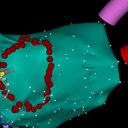Endothelial transdifferentiated phenotype and cell-cycle kinetics of AIDS-associated Kaposi sarcoma cells.
Keywords
Abstract
The nature of Kaposi sarcoma (KS) (vascular malignancy vs. discordant angiogenesis) and lineage of the progenitor cell remain unclear. Therefore, AIDS-KS enzyme isolate cultures were prepared from excised skin lesions. Endothelial marker positivity for Factor VIII related antigen (F8RAg), Ulex europaeus agglutinin (UEA), and angiotensin-converting enzyme (ACE) were determined by fluorescence microscopy (FM) and flow cytometry (FCM). DNA cell-cycle analysis was performed using FCM. KS lesions showed large thick-walled channels (F8RAg and UEA strongly +), narrow vascular slits and thin-walled lakes (F8RAg and UEA weakly +), and non-prominent spindle cells (F8RAg and UEA almost uniformly negative). KS cultures yielded heterogenous populations of spindle, stellate, and flattened endothelial-like cells, displaying positivity for F8RAg (64 +/- 3%; mean +/- SE), UEA (40 +/- 9%), and ACE (81 +/- 9%). When injected subcutaneously in the nude mouse these cells failed to produce tumors. During contact inhibition induced quiescence, KS cultures exhibited a high G2M (18 +/- 3%) compared to non-KS (7 +/- 4%; p < 0.04), evidence of an altered proliferative potential consistent with a transdifferentiated or transformed phenotype.


